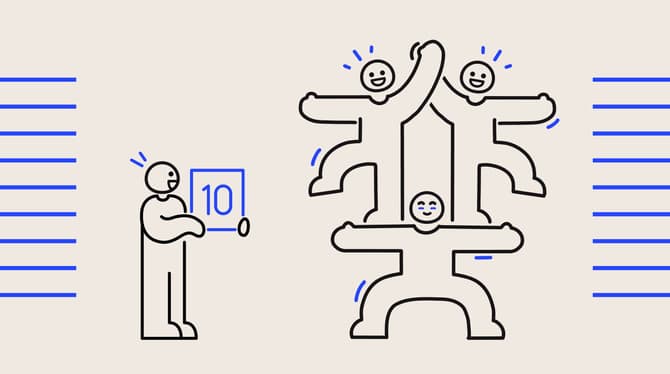Modern performance management plays a pivotal role in driving organizational growth and cultivating a thriving work environment.
By implementing an effective performance management system, teams and organizations can unlock numerous benefits, including increased employee engagement, improved productivity, enhanced collaboration, and better alignment of individual and company goals.
A well-designed performance management process empowers organizations to effectively manage and optimize individual and team performance. It sets the stage for clear communication, ongoing feedback, skill development, and employee recognition, all of which contribute to achieving organizational goals and fostering a positive work environment.
This article breaks down how to design the right performance management cycle. This starts by planning and setting the right steps to feed into a continuous loop of constructive feedback. We've also provided some handy tips for managers to lead this performance cycle and support improvement goals for employees.
Exclusive online summit
·
May 23 2024
Moments that matter: how to seed great work
Design the most effective performance management process
- What is a performance management process?
- Steps of the performance management process
- Continuous improvement: Evolving for success
- The role of leadership in effective performance management
- Tips for developing an effective performance management cycle
- How performance management software can help boost employee performance
What is a performance management process?
A performance management process is a systematic approach organizations use to set expectations, monitor progress, develop skills, provide feedback, recognize achievements, and drive continuous improvement.
It involves a series of interconnected steps designed to improve employee performance, align individual performance with organizational objectives, and create a culture of accountability and growth.
Steps of the performance management process
The performance management process is a comprehensive cycle that guides organizations in optimizing employee performance. By breaking it down into distinct steps, teams can effectively navigate this process, fostering growth, engagement, and success.
Let's explore the key steps that comprise an effective performance management cycle.
1. Planning: Setting the course for success
The first step in the performance management process is the planning stage. During this stage, clear team performance goals and expectations are established. By defining objectives that align with the organization's vision and strategy, teams gain a sense of purpose and direction.
👉 Try our goal-setter template to set individual goals that help your employees grow, while contributing to the company's success.
2. Monitoring: Tracking progress and providing support
Monitoring performance is essential to ensure progress towards established goals. Regular check-ins and feedback sessions allow managers to provide guidance, support, and recognition.
By using a tool with goal tracking and performance review features, teams can monitor individual and team progress, identify areas of improvement, and celebrate achievements along the way.
3. Developing: Nurturing growth and potential
The development step focuses on fostering continuous growth and improvement. This involves offering learning and development opportunities, coaching, and mentoring.
Performance management and coaching models create a culture of continuous improvement and provide a dynamic framework for nurturing growth, by fostering regular feedback, goal setting, and skill development.
⭐️ Officevibe's emphasis on continuous performance management and the effective use of the GROW coaching model can assist organizations in unlocking their employees' full potential.
4. Rating: Assessing performance objectively
Evaluate performance objectively is non-negotiable. Ratings or performance assessments provide a structured framework for measuring individual and team achievements against predetermined criteria. This step helps identify strengths, areas for improvement, and informs decision-making processes within the entire organization.
5. Rewarding: Recognizing and celebrating successes
Recognizing goal achievement and rewarding exceptional performance is a crucial aspect of the performance management process. By acknowledging individual and team achievements, organizations reinforce positive behaviors and motivate ongoing success.
🙌 There are many ways to increase employee recognition at work. Try them and watch motivation, engagement, and overall performance improve.
6. Renewing: Continuously enhancing performance
The final step in the performance management process is renewing. It involves reflecting on the outcomes, learnings, and areas for improvement from the previous cycle. By gathering feedback, analyzing results, and implementing changes, organizations make sure the performance management cycle evolves and adapts to meet evolving needs.
Creating a continuous performance cycle is key to successful performance management. So much so that we've dedicated the next section of this article to this!
Continuous improvement: Evolving for success
The performance management process is not a static endeavor but rather a dynamic cycle that requires continuous improvement and adaptability.
Organizations that embrace a culture of continuous improvement are better equipped to respond to changing business environments and evolving employee needs.
- Embrace feedback culture: Encourage an instant feedback culture where employees feel comfortable providing suggestions and insights on the performance management process. Regularly gather feedback from employees to identify areas for improvement and implement necessary changes.
- Agile goal setting: Adopt an agile performance management strategy to goal setting by regularly reviewing and adjusting goals based on changing priorities and circumstances. This flexibility ensures that goals remain relevant and aligned with organizational objectives.
- Emphasize learning and development: Promote a growth mindset and invest in employee learning and development. Provide opportunities for training, upskilling, and cross-functional learning to support continuous improvement and adaptability.
- Leverage technology advancements: Stay updated with technological advancements in performance management software. Explore new features and tools that can enhance the performance management process, such as AI-powered analytics, real-time feedback platforms, and collaborative performance management tools.
- Encourage experimentation: Encourage managers and teams to experiment with different approaches and techniques within the performance management process. Create a safe space for innovation and learning from failures to drive this continuous process.
- Regular process evaluation: Conduct regular evaluations of the performance management process to assess its effectiveness and identify areas for refinement. Analyzing metrics, gathering employee feedback, and benchmarking against industry best practices is all part of successful continuous performance management.
The role of leadership in effective performance management
Leadership plays a critical role in establishing and driving an effective performance management process. Leaders set the tone, create the framework, and provide the necessary support to ensure that performance management initiatives are successful.
- Commitment and communication: Leaders must demonstrate a genuine commitment to performance management and clearly communicate its importance to the organization. By emphasizing the value of performance management and articulating its link to organizational goals, leaders inspire buy-in and engagement from employees at all levels.
- Providing resources and support: Effective performance management requires adequate resources, including tools, training, and support systems. Leaders should allocate the necessary resources to enable managers and employees to actively participate in the performance management cycle. This includes providing training on performance management techniques, offering coaching and mentoring support, and ensuring access to technology platforms that streamline the process.
- Leading by example: Leaders must lead by example and actively participate in the performance management process. They should regularly engage in goal setting, provide feedback, and recognize employee achievements. By demonstrating their commitment to the process, leaders reinforce its importance and encourage employees to actively engage in their own performance management.
- Empowering managers: Leaders empower managers to effectively manage employee performance by providing them with the necessary authority, autonomy, and guidance. This includes equipping managers with the skills and tools needed to set clear expectations, provide constructive feedback, and support employee development. Leaders should also make sure managers have regular opportunities for training and development to enhance their performance management capabilities.
- Monitoring and accountability: Leaders play a crucial role in monitoring the progress and outcomes of the performance management process. They should regularly review performance metrics, provide guidance to managers, and hold them accountable for effectively managing employee performance. By actively monitoring the process, leaders can identify areas for improvement, address challenges, and celebrate successes.
- Continuous improvement and feedback: Effective leaders are committed to continuously improving the performance management cycle. They seek feedback from employees and managers, analyze data and insights, and make necessary adjustments to enhance the process. By fostering a culture of continuous improvement, leaders ensure that the performance management cycle remains relevant, impactful, and aligned with organizational goals.
Tips for developing an effective performance management cycle
Creating an effective and engaging performance management system is essential for driving individual and team success within an organization. As a leader or manager, you play a crucial role in building and cultivating such a system. Here are some valuable tips to help you develop a performance management approach that brings out the best in your team.
Establish clear expectations
Start by setting clear expectations for performance. Clearly communicate what is expected of each team member, including goals, targets, and key performance indicators.
Here are insightful tips on how to set team expectations effectively to help you navigate this crucial step.
Set goals together with your employees
Involve your employees in the goal-setting process to foster ownership and alignment. Collaboratively establish meaningful and challenging goals that drive motivation and growth.
To ensure your goal-setting process is both productive and empowering, check out our recommended goal-setting frameworks and performance goal examples.
Give frequent feedback
Provide regular feedback to your team members. Offer praise for goal completion and constructive guidance for improvement. Emphasize ongoing communication and create a culture where feedback is valued and welcomed.
To brush up your feedback skills, use our 22 constructive feedback examples and make a positive impact on your team's performance.
Provide support for underperformance
Support your employees' development by offering guidance and help. Address performance issues promptly and provide resources to help individuals enhance their skills and overcome challenges.
Officevibe's template for poor performance discussions can assist you in these conversations, fostering growth and improvement.
Talk about performance often
Engage in frequent discussions about performance, both formal and informal. One-on-one meetings can serve as valuable opportunities for informal check-ins, where you can discuss progress, challenges, and provide guidance.
By fostering open dialogue, you strengthen relationships and keep performance at the forefront.
Assess and adjust goals
Stay nimble by regularly assessing and adjusting goals. As circumstances change, make sure objectives remain relevant and aligned with organizational priorities. Address performance in real time and make necessary adjustments to keep individuals and teams on track. This agility ensures continuous improvement and adaptability.
Provide meaningful recognition
Recognize and appreciate exceptional performance to reinforce positive behaviors and motivate continued excellence. Meaningful employee recognition goes beyond simple praise; it acknowledges specific achievements and highlights their impact on the team and organization.
🤓 Read our 27 employee recognition messages examples for inspiration.
Foster a culture of continuous learning and development
Create an environment that values continuous learning and development. Encourage employees to seek out growth opportunities, offer training programs, and support their professional aspirations.
👀 Watch Officevibe's Vibe Check Episode 5 to discover how learning and growth can impact employee engagement and retention.
Use technology to streamline processes and collect data
Leverage technology to streamline performance management processes and gather meaningful data. Performance data collection helps identify trends, areas for improvement, and supports informed decision-making regarding promotions, bonuses, and career development. Using a performance management system can simplify data collection and analysis, enabling you to make data-driven decisions.
Create a fair and equitable process
Ensure fairness and equity throughout the performance management cycle. Consistently apply expectations, feedback, and rewards across the board, avoiding biases and discrimination at all costs. By promoting a transparent and unbiased approach, you foster trust and create a level playing field for all team members.
How performance management software can help boost employee performance
Performance management software can enhance team performance by streamlining goal setting, facilitating performance reviews, enabling timely feedback, promoting recognition, supporting data-driven decision making, and fostering collaboration.
With features such as goal tracking, feedback exchanges, recognition programs, and analytics dashboards, Officevibe empowers organizations to optimize their performance management process and drive motivated, aligned, and high-performing teams.
Equip HR and managers with tools to engage, recognize, and drive performance.




